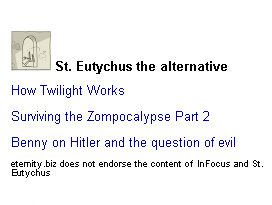There are times when I engage passionately in arguments when I don’t really mean it. There are other times when I engage passionately because the stakes are incredibly high and I think the issue is both theologically and strategically important. This, friends, is a case of the latter.
I’ve stirred up a veritable hornets nest of criticism both here and elsewhere for daring to question the assumption that people should stay in Sydney to do ministry. I thought it might have been one of those cases where I took an argument too far and risked causing offense. So I read my comments on Izaac’s blog a day later and in a rare moment of clarity and conviction found that I still completely hold on to every word I have written both here and elsewhere.
I did unwittingly cause Izaac some offense by quoting his post in an email to Phillip Jensen seeking clarification on his position. This was by no means my intention. Izaacs editorial surrounding the comments is balanced (and far less polemic than mine). I have no bone to pick with his contextualisation of the quotes. And I want to, in a public forum, apologise for the way in which I presented his views. I do think before I go further in criticising the statements attributed to Phillip I should find out if my criticisms are on the mark.
The irony of this situation is that I had heard recently, on another matter, that Phillip himself was critical of someone for speaking what everybody was thinking because “every statement is political”.
I wonder about the political wisdom of making a statement – polemical or otherwise – suggesting that areas of the country where there are more people than sheep (and I suspect removing the hyperbole this can be translated to rural Australia) – are of less strategic importance than the city. That’s not the attitude demonstrated by the ministry of Jesus, nor is it the attitude expressed in the parable of the lost sheep. People of all stripes and locations are important to God and need the gospel. Which means people of all stripes and locations need gospel workers with a heart for sharing the message of the cross.
It doesn’t seem to serve the cause of the gospel in reaching the rest of Australia and the world – but it does seem to serve the cause in Sydney. Phillip’s statements are fine in that they represent political statements that further his cause – gospel ministry in Sydney – I don’t really get the flack I’m wearing for disagreeing and presenting an alternative priority for growth in Australia.
It’s all well and good to suggest that other regions and states should be looking after themselves and setting up sustainable cities – but if you choose the Billy Graham crusades when the Jensen brothers were converted as the start of a groundswell of evangelicism in Australia, or if you choose any other moment in Australian history, the influence of Moore College as Australia’s premiere and premier training institution for evangelical workers needs time in order to create a cycle of self replication.
Here are a couple of potential case studies.
Case Study Number 1 – Maclean
Maclean, the town Izaac and I grew up in, has a population of about 3,500 people. It’s not a “strategic regional centre”. When my family moved their 20 years ago there was a night service meeting in Yamba (population 5,000) and two morning services – one in Lawrence (population – from memory less than 1,000) and the other in Maclean. We stayed in Maclean for ten years and by God’s grace left a thriving and gospel centred church family behind when we moved to Brisbane. Maclean has been vacant for almost half of the last ten years (by my guestimation). The strategic regional centre for the Lower Clarence is not Maclean – it’s Grafton. Grafton is the natural hub for small towns in the region. And holds the lion’s share of the regional population.
The church in Maclean has, again by the grace of God, produced a number of Godly young adults who still live in Maclean and a number who are serving in churches around the country – in Perth, Tasmania, Brisbane, Sydney and throughout New South Wales. For a town of less than 4,000 people Maclean is more than punching above its weight in terms of people entering theological training and ministry apprenticeships. But there has been a pretty long lead time. It has taken 20 years from the moment an evangelical ministry beginning in Maclean for two of us to be entering Bible College (and I think we’re the first). I can’t even truly claim to have completely grown up in Maclean (and Izaac rightly credits the faithful ministry he has received in Sydney for propelling him to where he is today).
To suggest that Maclean should have produced its own ministers to sustainably and strategically (as some have done both overtly and between the lines) look after the future of the region is disingenuous and doesn’t really take into account the nature of regional centres where a high percentage of young adults leave to seek their fortunes (and education) in the city.
According to Wikipedia 3.2% of residents of the Clarence Valley earn a living in “sheep, cattle or grain farming”… there’s a pretty good chance that there are more sheep in the region than cattle. According to the Clarence Valley Economic Development stats page more than 7% of residents are engaged in agriculture. ABS census statistics indicate that the Mid North Coast region (which includes Maclean) is home to approximately 3,000 sheep. It seems going to Maclean is ok. But not if it is a question of cattle rather than sheep. There are 409,000 head of cattle in the statistical division and 297,000 people. The region extends from Taree to Grafton. Maclean is typically rural.
For it to produce its own sustainable gospel work (on the assumption that this requires a home grown college trained worker) either Izaac or myself would have to go back there. I can’t for at least 8 years (candidacy locks me into Queensland for six) and Izaac would have to do two years of PTC training at the end of a four year degree. The suggestion that these regions should fend for themselves is pretty laughable.
Case Study Number 2: Townsville
I’ve spent the last four years in Townsville. It’s fair to say that evangelical ministry in Townsville is in its late infancy. There are perhaps five churches in Townsville that could be defined as evangelical. Townsville has a population of 180,000 people. It’s growing at about 5,000 people a year. All the ministers serving in Townsville have come there from elsewhere.
Dave Walker has been working for AFES in Townsville for (I think) nine years. AFES Townsville, again by the grace of God, has trained hundreds of students in that time. A number of these students are in full time ministry in high school chaplaincy, others have left Townsville for graduate positions. None, at this stage (to my knowledge) have entered theological training at this point. Nine years of fruitful labour has not been enough to meet staff shortfalls with the student ministry – let alone going close to providing enough workers for church ministry in the city.
I don’t think Dave will have a problem with me pointing out that AFES have been trying to appoint a female staff worker for the last couple of years – pursuing a number of candidates but attracting none to this point.
According to the ABS, North Queensland has no sheep, but it does have 496,000 head of cattle. Compared to Sydney the North Queensland region is an evangelical baby. It is not in a position to be self sustaining – give it 150 years and perhaps the region will have a population, and training college, similar to Sydney’s now. Sydney apologists can’t forget that they owe their strength to missionaries who came to Australia in the first fleet. All regions around the world, since Jerusalem and Judea, require workers to come in from the outside.
There aren’t all that many sheep in Queensland. Just 3.9 million. Luckily there are 4.1 million people. We should have no trouble filling vacancies in regional Queensland now should we?
I’m sure my friend Mike from Rockhampton could share equal tales of unrequited ministry opportunity – which is why those of us outside of Sydney get a little put out when we see a map like the one featured in this post.













